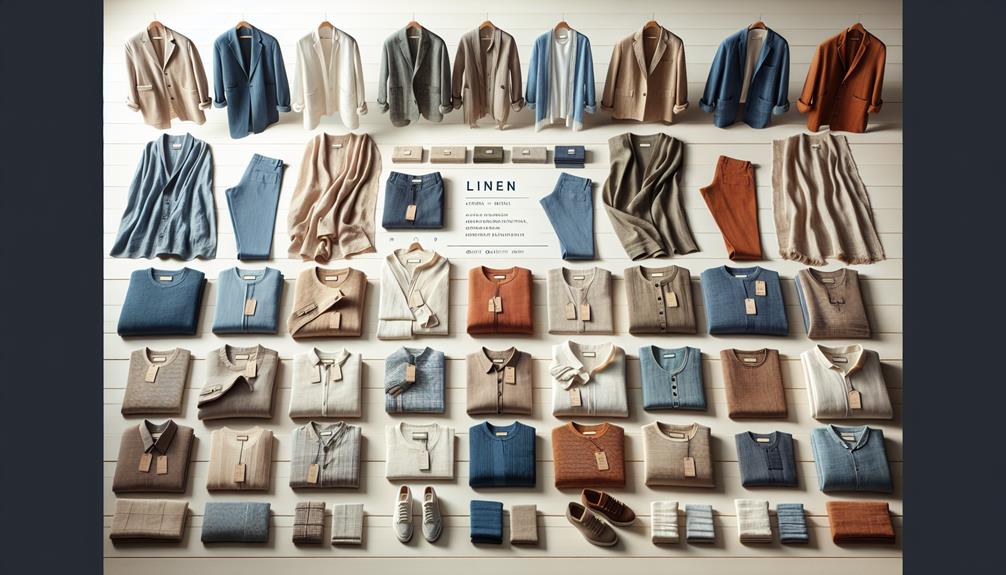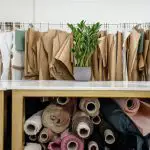Linen isn't a cheap fabric, but it's totally worth it for its quality and eco-friendly vibe. The price varies based on the intricate production process and high-quality materials. Despite the cost, people love it for its durability and breathability. Plus, it's super absorbent and naturally resistant to bacteria and insects. Linen's rarity and ethical production practices add to its value. So, if you're curious about why linen is so special, keep exploring!
Table of Contents
Key Takeaways
- Linen's price ranges from $5 to $12 per yard due to labor-intensive production and premium quality.
- Ethical labor practices, quality raw materials, and limited availability justify linen's cost.
- Despite being more expensive, consumers value linen for its durability, breathability, and sustainability.
- Linen's moisture absorbance and natural resistance properties contribute to its value despite the cost.
- Linen's durability, hygiene benefits, and breathability justify its price point, making it a valuable long-term investment.
Labor-Intensive Production Process
Linen's production process requires a significant amount of labor, making it far from a cheap fabric option. The labor-intensive nature of creating linen involves multiple steps like sowing seeds, harvesting, retting, scutching, spinning, and hand weaving. Skilled labor is essential at each stage, contributing to higher labor costs. Additionally, the slow production of linen, due to its fragile fibers and intricate hand weaving, further adds to the expenses involved.
Ethical labor practices are also a significant factor in linen production, ensuring fair wages and working conditions for workers. While these practices are commendable, they do contribute to the higher cost of linen fabric. The commitment to maintaining ethical standards throughout the production process not only safeguards workers' rights but also aligns with the values of consumers seeking transparency and sustainability in their purchases.
In essence, the combination of labor-intensive processes, skilled labor requirements, slow production methods, and ethical labor practices all contribute to the higher cost of linen fabric.
Price Range of Linen Fabric
When it comes to the price range of linen fabric, you'll find a varying cost from $5 to $12 per yard for woven linen, positioning it as one of the more expensive natural fibers available. This higher cost is justified by the labor-intensive production process and the use of high-quality raw materials that contribute to the premium nature of linen.
Despite its price tag, high-quality linen remains in demand for specific applications due to its unique properties and eco-friendly appeal. The cost of linen reflects its niche status in the modern textile industry, with challenges in production and limited availability compared to other fabrics.
Factors such as production location, raw material quality, and market demand all influence linen's price, establishing it as a premium fabric in the market. So, while linen may not be the cheapest option, its quality and characteristics make it a worthwhile investment for those seeking high-quality textiles.
Demand Despite High Cost
Despite its higher price compared to other fabrics, linen continues to experience high demand due to its exceptional qualities and benefits. Consumers are drawn to linen for its durability, breathability, and eco-friendly nature. While linen may come with a premium pricing, its sustainability aligns with the growing interest in eco-conscious fashion. Premium brands have also played a role in highlighting linen's unique qualities, emphasizing its quality and sustainability to justify the higher cost. This emphasis on quality and eco-friendliness has influenced consumers' willingness to invest more in linen garments.
The enduring popularity of linen can be attributed to its timeless appeal and positive environmental impact. Despite being one of the more expensive fabrics, the demand for linen continues to grow as consumers recognize its value as a sustainable and durable option. The unique blend of qualities that linen offers makes it a sought-after choice, proving that its benefits outweigh its cost in the eyes of many consumers.
Moisture Absorbance Property
So, let's talk about linen's moisture absorbance!
Linen has this amazing ability to soak up moisture, holding up to 20% of its weight in water.
This unique trait makes linen a top choice for staying dry and comfortable in humid weather.
Linens Moisture Absorption
Linen's exceptional moisture absorbency, capable of soaking up to 20% of its weight in moisture, makes it a highly sought-after fabric for various textile products. When it comes to moisture absorption, linen stands out for its absorbent nature, which benefits clothing, towels, and bedding.
- Regulating Body Temperature: Linen's absorbent properties help wick away moisture from the body, aiding in regulating body temperature.
- Comfort in Warm Weather: The moisture-wicking ability of linen makes it a comfortable choice for warm weather, keeping the skin dry and cool.
- Hygiene and Freshness: Linen's natural moisture absorption not only prevents bacterial growth but also contributes to a fresh and hygienic feel.
Linens Breathability Trait
With its exceptional moisture absorbency, linen's breathability stands out as a key trait that enhances comfort in warm climates. Linen can absorb up to 20% of its weight in moisture without feeling damp, making it a comfortable choice for those hot days.
The fabric's natural properties help regulate body temperature by wicking away moisture, keeping you cool and dry. In warm climates, this essential for allowing air circulation, making linen ideal for both clothing and bedding.
The ability of linen to keep you comfortable and fresh by efficiently managing moisture sets it apart as a top choice for those seeking breathable fabrics in hot weather.
Natural Resistance Benefits
So, let's talk about why linen's natural resistance is a game-changer.
First off, its durability is off the charts, making it a top choice for long-lasting products.
Plus, the breathability and allergy-friendly properties make it a winner in my book!
Durability in Linen
In my experience, linen's exceptional durability stems from its natural resistance to bacteria, acarids, and insects, making it a reliable choice for those prone to allergies. Linen's ability to withstand wear and tear while repelling harmful organisms sets it apart as a long-lasting fabric with added health benefits.
Here are three key reasons why linen's durability through natural resistance is advantageous:
- Hygienic Advantage: Linen's innate resistance to bacteria and pests guarantees a cleaner and more hygienic environment, ideal for those with sensitivities.
- Extended Longevity: The fabric's ability to repel unwanted organisms contributes to its longevity, making linen products a sustainable choice.
- Value Retention: Despite being a premium fabric, linen's durability and natural resistance help maintain its value over time, offering lasting benefits to the user.
Breathability Advantage
Moving on from discussing linen's durability due to its natural resistance to bacteria, acarids, and insects, let's explore the breathability advantage of this fabric. Linen's breathability is a standout feature, allowing air to circulate freely, making it perfect for warm climates and active wear. This fabric's ability to wick away moisture helps in keeping the skin dry and comfortable, making it an excellent choice for those seeking hygienic and hypoallergenic options. The breathability and comfort of linen make it a top pick for individuals with sensitive skin or allergies. Below is a table highlighting some key points about linen's breathability advantage:
| Key Benefits | Description |
|---|---|
| Breathable Fabric | Allows air to flow freely through the fabric |
| Moisture-Wicking | Helps keep the skin dry and comfortable |
| Hygienic & Hypoallergenic | Suitable for individuals with sensitive skin or allergies |
| Ideal for Warm Climates & Active Wear | Perfect for hot weather or sports activities |
Allergy-Friendly Properties
Discussing linen's allergy-friendly properties reveals its natural resistance benefits, making it a preferred choice for individuals with sensitivities. Linen's hypoallergenic nature and ability to resist bacteria and allergens make it a top pick for those prone to allergies or with sensitive skin.
Here are three reasons why linen is an excellent option for allergy sufferers:
- Hypoallergenic Properties: Linen's hypoallergenic features reduce the risk of triggering allergic reactions.
- Natural Resistance: Linen's natural resistance to bacteria and allergens enhances its suitability for those with sensitivities.
- Hygienic Qualities: The fabric's ability to repel microbes contributes to its hygienic properties, promoting a healthier environment for allergy-prone individuals.
Longevity and Durability
Linen's durability stands out as evidence of its robust flax fibers and resistance to wear and tear, making it a long-lasting investment for any wardrobe. The fabric's capability to uphold its quality over time is impressive. With proper care, linen pieces can last for years, becoming even softer and more comfortable with each wash.
Unlike some other fabrics, linen can withstand high temperatures and sunlight, further contributing to its longevity. Despite the initial higher cost compared to other materials, the durability of linen makes it a wise choice in the long run. The inner strength of linen fibers guarantees that it can endure repeated use without losing its shape or quality.
Additionally, linen's production requires less water than cotton, making it not only durable but also more environmentally friendly. Investing in linen pieces means investing in durable, long-lasting items that can withstand the test of time.
Eco-Friendly Characteristics
Linen stands out as an eco-friendly choice due to its renewable resource benefits and biodegradable properties. Its cultivation requires minimal water and pesticides, and the natural pest-resistant nature of flax reduces the need for harsh chemicals.
Opting for linen not only supports sustainable practices but also aligns with the values of eco-conscious consumers like me.
Renewable Resource Benefits
When considering eco-friendly characteristics, linen stands out as a fabric sourced from a rapidly renewable resource with minimal environmental impact. Here are three reasons why the renewable resource benefits of linen make it a sustainable choice:
- Flax fibers: Linen is crafted from flax fibers, a renewable resource that grows quickly and requires minimal water and pesticides, reducing its environmental footprint.
- Natural pest resistance: Flax cultivation for linen production boasts natural pest resistance, decreasing the need for harmful chemicals and promoting eco-friendly practices.
- Biodegradable: Linen is biodegradable, meaning it naturally decomposes without leaving harmful residues, making it an environmentally conscious option for consumers.
These factors highlight linen's commitment to sustainability and align with the increasing demand for eco-friendly textiles.
Biodegradable Properties of Linen
Given its ability to naturally break down without harming the environment, linen's biodegradable properties make it a standout choice for eco-friendly and sustainable fashion.
Linen, as a biodegradable material, decomposes easily, unlike synthetic fabrics, which helps reduce waste accumulation. Opting for linen over non-biodegradable alternatives promotes a more environmentally friendly fashion industry.
Its green fabric status is further solidified by the fact that linen isn't only eco-friendly but also sustainable in the long run. The fashion industry is increasingly recognizing the importance of using biodegradable materials like linen to lessen its impact on the environment.
Choosing linen isn't just a stylish choice but also a responsible one for those looking to support eco-conscious practices.
Rarity in Fabric Market
Amidst the fabric market's vast array of options, the rarity of linen stands out as a defining factor in its luxury status. Linen's unique qualities and scarcity make it a premium choice, commanding a higher price due to its limited availability.
- Exclusivity: Linen's scarcity sets it apart from more common fabrics, making it a sought-after option for those who appreciate quality and prestige.
- Market Demand: The limited availability of high-quality linen drives up its market demand, as consumers are willing to pay a premium for this luxurious fabric.
- Quality Positioning: Linen's exceptional properties and the precise conditions required for its cultivation position it as a higher-priced fabric in the industry, catering to those who value sophistication and elegance in their textiles.
Challenges in Harvesting Process
Managing the labor-intensive process of uprooting flax plants for linen production presents significant challenges in the industry. Each flax plant must be carefully uprooted to guarantee the maximum fiber length, which is essential for producing high-quality linen.
However, this meticulous task adds to the high cost of linen due to the manual work involved in the uprooting process. The tedious nature of uprooting each plant individually contributes to production challenges, making it a time-consuming endeavor for manufacturers. Despite the challenges, proper uprooting is indispensable for guaranteeing the quality of the linen being manufactured.
Balancing the need for longer fibers with the labor-intensive process is an ongoing challenge for the industry. As a result, finding efficient ways to manage the uprooting process is crucial to streamline production and maintain the high standards necessary for quality linen production.
Fair Labor Practices Impact
Exploring the domain of fair labor practices in linen production sheds light on the intricate tapestry of factors influencing the fabric's cost and quality. When considering fair labor practices, several key points come into play:
- Skilled Labor Requirements: Fair labor practices in linen production contribute to higher costs as skilled artisans are essential for tasks such as hand-weaving, which demand expertise and precision.
- Ethical Labor Practices: Upholding ethical labor practices, like providing fair wages and ensuring good working conditions for laborers, increases the price of linen but aligns with principles of social responsibility and sustainability.
- Sustainable Manufacturing: Investments in ethical labor practices not only guarantee fair wages for workers but also support sustainable manufacturing processes, ensuring that the linen industry operates in an environmentally responsible manner.
Frequently Asked Questions
Is Linen an Expensive Fabric?
Linen is considered an expensive fabric due to its labor-intensive production and high-quality nature. Factors like skilled labor, fair practices, and unique properties justify its premium pricing. Despite the cost, linen's durability and eco-friendliness make it worthwhile.
Is Linen a Cheap Material?
Linen isn't a cheap material, but its worth goes beyond price. The labor-intensive process and quality materials make it pricier. Yet, its durability, eco-friendly nature, and comfort make it a smart investment for those valuing quality.
What Is the Disadvantage of Linen?
Maintaining linen can be tricky; it wrinkles easily and may shrink if not handled properly. The extra care needed for this fabric, along with its higher price tag, can be seen as disadvantages for budget-conscious shoppers.
Is Linen a Good Quality Fabric?
Linen is undeniably a good quality fabric. Its durability, breathability, and natural properties make it a top choice. With skilled production techniques and unique textural qualities, linen stands out as a superior and timeless option.
- Does Linen Keep You Cool at Night? - April 9, 2024
- Is Linen Cool for Sleeping? - April 9, 2024
- Is Linen Sun Proof? - April 9, 2024








